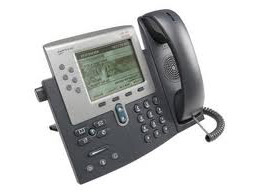Thinking about Voice over IP? If so, you should seriously consider talking with Dan Aylward at Abilita (517) 853-8130. A few years back, Dan analyzed my phone service to see if I was missing out on savings; turned out, I was (I have hundreds of phones) and without spending a cent, Dan made the changes; Dan’s cut came from a percentage of the savings over a short time period – a true win-win arrangement.
 Dan sent me the following overview of VoIP by Mark Price, an Abilita colleague of his, which I thought I’d share with you – it does a great job at explaining this technology in a way anyone can understand.
Dan sent me the following overview of VoIP by Mark Price, an Abilita colleague of his, which I thought I’d share with you – it does a great job at explaining this technology in a way anyone can understand.
Internet Protocol (VoIP) Right for Your Business?
Because of the cost efficiency and functionality of VoIP systems, many businesses are taking a long, hard look at their current communication systems to decide if it’s time to make a switch. Though VoIP is increasingly popular, it is not the perfect fit for every business.
With VoIP the caller’s voice is broken down into bits of data, which then are sent over the Internet (or LAN or MPLS) to the receiving location and reassembled, completing the process. On average a VoIP call will use up to 90 Kbps (kilobits per second). One thing that makes VoIP so efficient is that VoIP calls can share space on a network and don’t require their own circuit, as with traditional copper line phone systems. In addition, because the calls are placed digitally, the sound quality of VoIP calling is equal to, if not better than, traditional phone lines so long as there is no bandwidth or voice prioritization issues. Otherwise a caller might experience echo or clipping.
Businesses considering switching to VoIP should take the following issues into consideration when determining if VoIP is right for their individual needs:
There are two types of VoIP deployments: Hosted and On-premise. In a Hosted VoIP environment, the service provider manages all of the equipment and network requirements necessary to provide VoIP service, with the exception of the handset device which is deployed to users as well as the cost of network access. In effect, the user buys the right to use the service and typically pays for the network cost to access the service. The VoIP application is in the ‘cloud’. An On-premise solution is typically where a user invests in all of the equipment needed to run and manage the capability to deploy the VoIP application on their own. Here, the user bears responsibility for the VoIP service. There are many reasons to consider either solution. In many cases the larger the organization, the more they are likely to invest in the On-premise solution. This discussion will focus primarily on considering a hosted solution.
Hardware Costs
 In any type of telecommunications transition, one important consideration is the cost of equipment required for the upgrade. With VoIP, the equipment to consider is the phone itself. VoIP can use “hard” phones and “soft” phones. “Soft” phones are software programs that are used on a computer that has a sound card, network card, connection to the network, and either speakers and a microphone or an external headset. “Hard” phones look like traditional phones but the phone is designed to be able to work on a network. Other options are USB phones or older phones equipped with an adapter. Because there are options for using VoIP with existing computers or traditional phones, it is possible to switch to a VoIP system with little or no equipment upgrade costs.
In any type of telecommunications transition, one important consideration is the cost of equipment required for the upgrade. With VoIP, the equipment to consider is the phone itself. VoIP can use “hard” phones and “soft” phones. “Soft” phones are software programs that are used on a computer that has a sound card, network card, connection to the network, and either speakers and a microphone or an external headset. “Hard” phones look like traditional phones but the phone is designed to be able to work on a network. Other options are USB phones or older phones equipped with an adapter. Because there are options for using VoIP with existing computers or traditional phones, it is possible to switch to a VoIP system with little or no equipment upgrade costs.
Internet Disruptions
One potential problem for Internet Telephony customers is that disruptions can occur if there are issues with the Internet service provider’s network or extremely high usage of the Internet connection. Though this is not, in itself, a reason to disregard VoIP as an option, the Internet connection should be evaluated to determine if there are likely to be issues. If so, businesses can look into ways of improving the connection or explore alternative service providers. Power outages can also disrupt Internet service and, therefore, VoIP systems. To partially remedy this problem, select a VoIP provider that includes “call forwarding on non-registration” services. With this service, if the VoIP connection is lost, incoming calls will be forwarded to cell phones for the duration of the outage. Outgoing calls will be disrupted.
Freedom of Location
VoIP offers a freedom of location that can be extremely beneficial to businesses that have multiple locations but want to have one centralized contact point; may be upgrading or changing locations in the future; or have employees that travel or telecommute. Because day-to-day maintenance and operations of VoIP systems are executed by the provider, the provider can be called upon to make location changes remotely and with little burden to the business. This online access to VoIP infrastructure allows the system to function independently of the building itself. A company phone set plugged into any adequate Internet connection will function as if it were still in its original location. Therefore telecommuters and traveling employees can simply take their phones with them and operate normally.
Faxing
Unified Communications is the integration of different electronic communications media into a single interface. Deployment of VoIP brings a number of functions into the platform, e.g. instant messaging and voicemail. However, one issue to consider is faxing. Businesses that rely heavily on faxing or send and receive detailed, high-resolution documents via fax or frequently fax documents that are more than four pages in length are better off maintaining a copper phone line for faxing purposes because of the decreased stability of faxing over VoIP under these circumstances. However, some businesses use an alarm system that works over a copper line and in this situation; the same copper line for the alarm system can be used for faxing. Additionally, users can fax via scanning and emailing or utilizing a fax server.
Features
Though options will vary from vendor to vendor and businesses should always ask prospective vendors about rates and features, options for VoIP systems usually include caller ID, caller ID block, 3-way calling, call return, call forwarding, call waiting, voicemail, online voicemail access, email voicemail alerts, unlimited local calling, unlimited long distance calling, online call logs, choice of area code and the ability to keep the existing phone number.
Conclusion
When considering the switch to VoIP, it is imperative that an organization consider every aspect of their business that will be affected by the switch. In addition, businesses should remember that not all VoIP service providers are created equally. Once the needs of the business have been evaluated (and if it is determined that a change should be made), a variety of service providers should be contacted to determine which one can meet all of those needs. Organizations can invest in hybrid phone systems that utilize some VoIP and some traditional in order to control costs. Deployment of a VoIP solution might result in a lower cost structure or increased cost structure. It is important to understand how the staff will benefit from the increased productivity VoIP can provide versus any increased costs.
Finally, always remember that trends in telecommunications do not necessarily indicate that a change is needed. The needs of the business alone should control telecommunications decisions.
If you are wondering if you’re paying too much and could be saving money, or if you’re considering a new VoIP System, give Dan Aylward a call at (517) 853-8130 – he is trustworthy (hard to find in this business!) and it won’t cost you a cent!
